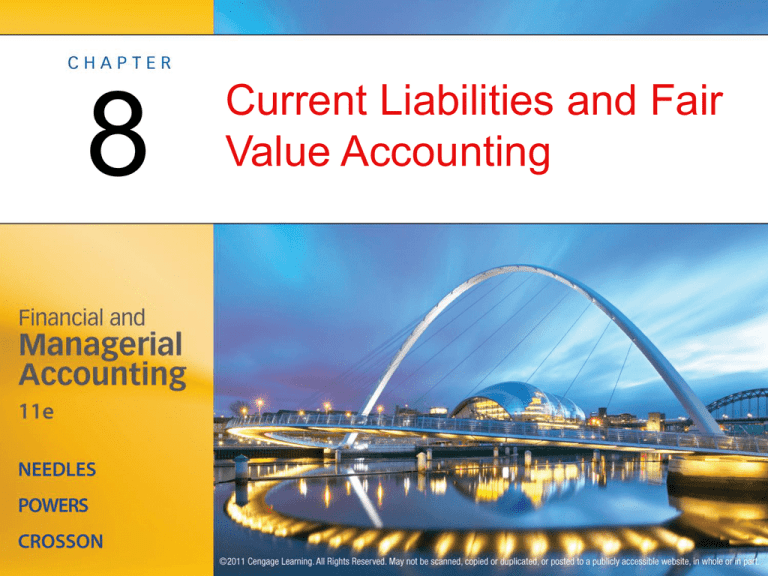
8
Current Liabilities and Fair
Value Accounting
Management Issues Related to Current
Liabilities
OBJECTIVE 1: Identify the management
issues related to current liabilities.
Key Ratios
• Payables turnover
• Days’ payable
Figure 1: Payables Turnover for Selected
Industries
Figure 2: Days’ Payable for Selected
Industries
Management Issues Related to Current
Liabilities
• Liabilities are legal obligations that must be
satisfied through the future payment of
assets or performance of services.
– A liability should be recognized when it is
incurred; end-of-period adjustments may be
necessary.
• Failure to record a liability often results in an
understatement of expenses.
Management Issues Related to Current
Liabilities
• Liabilities are legal obligations that must be
satisfied through the future payment of
assets or performance of services.(cont.)
– Liabilities are valued at the amount due or at
the fair market value of goods or services to be
delivered.
Management Issues Related to Current
Liabilities
• Liabilities are legal obligations that must be
satisfied through the future payment of
assets or performance of services.(cont.)
– Liabilities are classified as current or longterm.
• A current liability is a liability due within one year
or within the normal operating cycle, whichever is
longer.
• A long-term liability is a liability due beyond the
normal operating cycle.
Management Issues Related to Current
Liabilities
• Two common measures of the length of
time creditors allow for payment are the
payables turnover and the days’ payable.
– The payables turnover is the average number
of times that accounts payable are paid in an
accounting period and shows the relative size
of a company’s accounts payable.
– The days’ payable shows the average length of
time a company takes to pay its accounts
payable.
Management Issues Related to Current
Liabilities
• Required disclosures for liabilities include
the following:
–
–
–
–
–
Balances
Maturity dates
Interest rates
Lines of credit
Other special credit arrangements
©2011 Cengage Learning All Rights Reserved. May not be scanned, copied or duplicate, or posted to a publicly accessible website, in whole or in part.
Common Types of Current Liabilities
OBJECTIVE 2: Identify, compute, and record
definitely determinable and estimated
current liabilities.
Figure 3: Promissory Note
Figure 4: Illustration of Payroll Costs
Common Types of Current Liabilities
• Current liabilities consist of definitely
determinable liabilities and estimated
liabilities.
Common Types of Current Liabilities
• A definitely determinable liability can be
measured precisely.
– Accounts payable
– Bank loans and commercial paper
Common Types of Current Liabilities
• A definitely determinable liability can be
measured precisely. (cont.)
– Notes Payable
• Notes payable with interest stated separately.
– Issue note.
– Accrue interest.
– Pay note.
• Notes payable with interest included in the face
amount.
– Issue note.
– Accrue interest.
– Pay note.
Common Types of Current Liabilities
• A definitely determinable liability can be
measured precisely.(cont.)
–
–
–
–
Accrued liabilities (such as interest payable)
Dividends payable
Sales and excise taxes.
Current portion of long-term debt
Common Types of Current Liabilities
• A definitely determinable liability can be
measured precisely.(cont.)
– Payroll liabilities
• Record the payroll.
• Record employer payroll taxes.
– Unearned revenues
• Receipt of revenues in advance.
• Performance of services for revenues received in
advance.
Common Types of Current Liabilities
• Estimated liabilities are definite obligations
whose exact amounts cannot be known
until a later date.
– Record estimated income taxes.
– Property taxes
• Estimated expense.
• Payment of property taxes.
Common Types of Current Liabilities
• Estimated liabilities are definite obligations
whose exact amounts cannot be known
until a later date. (cont.)
– Promotion costs
• Examples: coupons, rebate, frequent flyer
programs
• Usually recorded as a reduction in revenue (contrasales account)
Common Types of Current Liabilities
• Estimated liabilities are definite obligations
whose exact amounts cannot be known
until a later date. (cont.)
– Product warranties
• Estimated expense.
• Replacement of product under warranty.
– Vacation pay
• Estimated vacation pay expense.
• Payment of vacation pay.
Common Types of Current Liabilities
Common Types of Current Liabilities
Common Types of Current Liabilities
Common Types of Current Liabilities
Common Types of Current Liabilities
Common Types of Current Liabilities
Common Types of Current Liabilities
©2011 Cengage Learning All Rights Reserved. May not be scanned, copied or duplicate, or posted to a publicly accessible website, in whole or in part.
Contingent Liabilities and Commitments
OBJECTIVE 3: Distinguish contingent
liabilities from commitments.
Contingent Liabilities and Commitments
• A contingent liability is a potential liability
that may or may not become an actual
liability. Examples are as follows:
– Pending lawsuits
– Tax disputes
– Failure to comply with government regulations
Contingent Liabilities and Commitments
• There are two criteria for recording a
contingent liability:
– Occurrence is probable.
– The amount can be reasonably estimated.
Contingent Liabilities and Commitments
• A commitment is a legal obligation that
does not meet the technical requirements
for recognition as a liability. Examples are
as follows:
– Purchase agreements
– Leases
©2011 Cengage Learning All Rights Reserved. May not be scanned, copied or duplicate, or posted to a publicly accessible website, in whole or in part.
Valuation Approaches to Fair Value
Accounting
OBJECTIVE 4: Identify the valuation
approaches to fair value accounting, and
define time value of money and interest and
apply them to present values.
Table 1: Present Value of $1 to Be Received at the
End of a Given Number of Periods
Table 2: Present Value of an Ordinary $1 Annuity
Received in Each Period for a Given Number of
Periods
Valuation Approaches to Fair Value
Accounting
• Fair value is the price for which an asset or
liability could be sold.
– Market approach
• Involves identical or comparable assets or
liabilities.
• Ready market not as available, as in case of specialpurpose equipment.
Valuation Approaches to Fair Value
Accounting
• Fair value is the price for which an asset or
liability could be sold.(cont.)
– Income (or cash flow) approach
• Converts future cash flows into a single present
value.
• Based on reasonable internally generated
information.
Valuation Approaches to Fair Value
Accounting
• Fair value is the price for which an asset or
liability could be sold.(cont.)
– Cost approach
• The amount that currently would be required to
replace an asset.
• Inventory usually valued at lower of cost or market.
• Plant value would take into account asset’s age,
condition, depreciation, and obsolescence.
Valuation Approaches to Fair Value
Accounting
• Interest and the time value of money
– Time value of money is the effects of the
passage of time on holding or not holding
money.
Valuation Approaches to Fair Value
Accounting
• Interest and the time value of money (cont.)
– Interest is the cost of using money.
• With simple interest, interest is not computed on
accrued interest.
• With compound interest, interest is computed on
accrued interest.
Valuation Approaches to Fair Value
Accounting
• Calculating present value
– Illustrate the computation of the present value
of an amount, using Table 1 in the text.
– Illustrate the computation of the present value
of an annuity, using Table 2 in the text.
Valuation Approaches to Fair Value
Accounting
• Calculating present value (cont.)
– Discuss time periods of less than one year for
which interest is compounded.
• Some savings accounts can record interest
quarterly.
• Some bonds pay interest semiannually.
©2011 Cengage Learning All Rights Reserved. May not be scanned, copied or duplicate, or posted to a publicly accessible website, in whole or in part.
Applications Using Present Value
OBJECTIVE 5: Apply the present value to
simple accounting situations.
Applications Using Present Value
• Present value has several applications in
accounting:
– Determine the value of an asset considered for
purchase.
– Calculate deferred payments.
– Account for idle cash invested.
Applications Using Present Value
• Present value has several applications in
accounting: (cont.)
– Accumulate funds to pay off a loan.
– Other applications, such as imputing interest
on non-interest-bearing notes, accounting for
installment notes, determining the value of a
bond, pension and lease obligations, and
depreciation of property, plant, and equipment.
©2011 Cengage Learning All Rights Reserved. May not be scanned, copied or duplicate, or posted to a publicly accessible website, in whole or in part.










